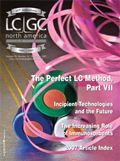Peaks of Interest
Millipore Corporation (Billerica, Massachusetts) announced the availability of the new Milli-Q Integral water purification system, which uses tap water to supply constant-quality Type II (pure) and Type I (ultrapure) water from a single water production unit.
Millipore Launches Water Purification System
Millipore Corporation (Billerica, Massachusetts) announced the availability of the new Milli-Q Integral water purification system, which uses tap water to supply constant-quality Type II (pure) and Type I (ultrapure) water from a single water production unit.
The system combines Millipore's proven superior Elix technology with the best-in-class Milli-Q solution to produce pressurized pure and ultrapure water, providing users with direct control over water quality throughout the entire purification process. Users also benefit from low maintenance and well-controlled running costs, thanks to Elix technology and its ion-exchange resins, which are continuously regenerated by a weak electric current.
Thermo Fisher Scientific Partners with Phytronix Technologies
Thermo Fisher Scientific, Inc. (San Jose, California) announced a strategic partnership with Phytronix Technologies, a Canada-based company, for the use of laser diode thermal desorption (LDTD) technology. LDTD technology enhances the existing Thermo Scientific TSQ Quantum LC–MS product portfolio by offering ultra fast sample analysis for both quantitative and qualitative applications in high-throughput drug discovery, drug development, food safety, and environmental applications.
JASCO and Restek Announce Collaboration
JASCO, Inc. (Easton, Maryland) and Restek Corporation (Bellefonte, Pennsylvania) announced a collaboration in the area of UHPLC instrumentation and 1.9-μm UHPLC columns. Restek will supply small particle column kits that will be included with JASCO instruments.
Pittcon 2008 Releases Topics for Conferee Networking Sessions
The Pittsburgh Conference released the topics for the Conferee Networking Sessions (CNS) which will be offered at Pittcon 2008, March 2 —7, 2008, in New Orleans at the Ernest N. Morial Convention Center. Conferee Networking Sessions were first introduced at Pittcon 2007, and the eight sessions offered were reportedly a tremendous success.CNS Chairman Pat Bordell commented, "We were very pleased with the conferee participation in last year's sessions and wanted to build on that success for this year." One of the goals for Pittcon 2008 was to increase the number of sessions to provide more diversity in the program. She further stated, "We believe this year's expanded program that includes 27 sessions will provide a most unique and rewarding networking opportunity for conferees."

HPLC 2025 Preview: Fundamentally Speaking (Part 1)
May 13th 2025Michael Lämmerhofer from the Institute of Pharmaceutical Sciences, University of Tübingen, Germany, spoke to JFK Huber Lecture Award winner of 2024 Torgny Fornstedt, professor in analytical chemistry and leader of the Fundamental Separation Science Group, Karlstad University, Sweden, about his pioneering work in high performance liquid chromatography (HPLC) with a focus on fundamentals and industrial applications.
Reversed-Phases for LC Deliberately Doped with Positive Charge: Tips and Tricks for Effective Use
May 13th 2025In this month's edition of LC Troubleshooting, Dwight Stoll and his fellow researchers discuss both the benefits (improved peak shape/loading) and challenges (excessive interaction) associated with charge-doped reversed-phase (RP) columns for both analytical and preparative separations.
Determining Ways to Protect Honeybee Colonies with GC–MS
May 13th 2025A study conducted by the Agriculture Research Centre of Giza, Egypt, and Jilin Agricultural University in China, evaluated the efficacy of stinging nettle extract, nettle smoke, and formic acid in the controlling of Varroa mites, a major threat to honeybee colonies, with a focus on mite infestation reduction, honeybee mortality, and biochemical responses. Gas chromatography–mass spectrometry (GC–MS) was used to identify key bioactive compounds in the stinging nettle extract.

.png&w=3840&q=75)

.png&w=3840&q=75)



.png&w=3840&q=75)



.png&w=3840&q=75)









